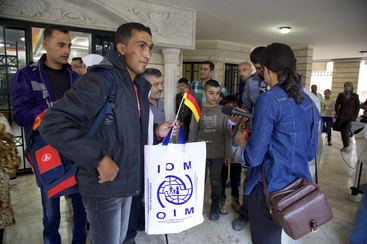Merkel, the Abyssinian: Imaginaries of Refuge and Migration
January 07, 2016 • By Alexander-Kenneth Nagel
We’ve learned one thing from the European refugee crisis over the past few months: Immigration is all about images. While the decision to emigrate is usually the result of concrete factors like civil war, persecution, or poverty, the destination is often less well-defined. As migrants begin for new lands, they are guided by dreams of home and shelter. These days, Europe has become the “promised land” for more than a million refugees from Syria, Afghanistan, and Eritrea, most of whom have sought—or are seeking—asylum in Germany and Sweden. In a memorable press conference on August 31st, the German chancellor Angela Merkel affirmed her country’s capacity and willingness to receive Syrian refugees with three magical words: “Wir schaffen das” (We can do it).
Merkel’s action may have seemed straightforward, but her gesture took on very different symbolic meanings. Conservative politicians throughout Europe criticized Merkel for extending an invitation to the global South. The conservative British magazine “The Spectator” called the decision “a tragic mistake” and portrayed Merkel as the Lorelei, a mythical figure who was said to lead sailors astray with her ethereal singing.
In the Middle East, however, the image was completely different. After Merkel´s announcement, social media networks overflowed with metaphors of gratitude. On Facebook, Syrians dubbed the chancellor “Mama Merkel.” Another narrative, which was spread on Twitter, called Merkel “the Abyssinian,” a Quranic allusion to a Christian king who provided shelter to Muslim refugees to his kingdom of Axum (formerly called Abyssinia, now Eritrea and part of Ethiopia) in the early days of Islam.
The power of religious imaginaries is not restricted to public discussions or media campaigns, but also permeates academic debates on religion and migration. Migrant communities have been conceptualized by scholars as “ethnic colonies” or “parallel societies.” While these scholars respond to the valid concern to create cohesion in a fragmented society, both images are negative. The idea of a “parallel society” calls up a geometric metaphor: parallel lines never touch each other. Such a notion does not account for the fluidity of religion and culture. The term “ethnic colony” seems even more problematic, with its reliance on imperial terms. Where are the counterbalancing positive images, to help us see how refugees and immigrants are already integrating into and contributing to the mainstream?
Since the end of World War II, Germany has been a destination for immigrants. Between 1944 and 1950, more than 12 million refugees arrived in Germany from the former eastern territories of Germany. Thanks to an economic recovery in the 1960s, West Germany signed recruiting agreements that led to large-scale labor migration from countries such as Italy, Spain and Turkey. While the majority of these labor migrants were Christian, there was also a substantial Muslim minority. Today, this religious pattern is being reversed; far more migrants to Germany are Muslim, rather than Christian. As a result, Islamophobic movements such as the “Patriotic Europeans Against the Islamisation of the Occident” are on the rise. Even highly secularized countries like Hungary and Slovakia are rediscovering their Christian roots in order to avoid Muslim immigration. Earlier this year, Slovakian officials declared that they would only accept Christian refugees from Syria, claiming that Muslim migrants wouldn’t feel at home in their country.
In Germany, narratives of Muslims as guests in a Christian land are still common—even among refugees themselves, as the invocation of “Merkel the Abyssinian” shows. But Muslims are now a permanent part of Germany’s religious landscape, both in terms of numbers and self-organization. There are about four million Muslims in Germany (compared to 2.6 million in the United States) who make up more than five percent of the population (compared to 0.8 percent in the U.S.). The Muslim labor migrants of the 1960s built up an impressive religious infrastructure with more than 2500 mosques, which can now be put to use in order to accommodate the needs of Muslim refugees from Syria and Afghanistan. For the past five decades, the leaders of these mosques have cultivated a version of Islam that is embedded in the realities of German everyday life.
In fact, the crisis may become an opportunity to develop a new image of Islam in Germany that transcends old visions of hospitality. The new influx of refugees offers a chance for Muslim associations to present themselves as hubs of civic engagement and engines of religious innovation. As German mainline Christian churches face membership losses and internal restructuring, Muslims are increasingly seen as partners in a joint post-secular project.
For example, when the Bishop of Essen planned to close six Catholic parishes in the west German town of Duisburg in 2012, the local mosque association intervened on behalf of several of its neighboring churches, based on their history of interfaith cooperation. Their show of solidarity resulted in the preservation of one parish in Duisburg-Marxloh, which has now become an important center of refugee aid. This episode shows the potential for Muslim organizations to serve as hubs of inclusion within German society, not merely as the recipients of German hospitality. A new narrative of Muslims in Germany is starting to take shape.
Read a Q&A with Alexander-Kenneth Nagel about his research here.
Photo courtesy of International Organization for Migration via Flickr (Creative Commons).